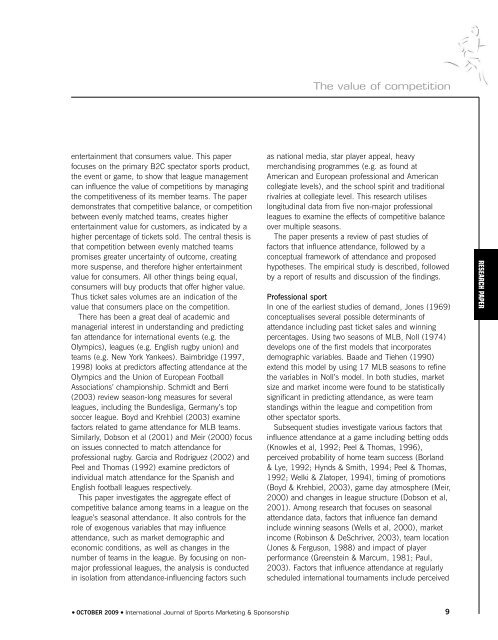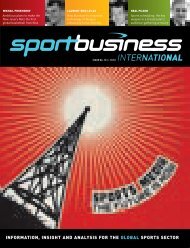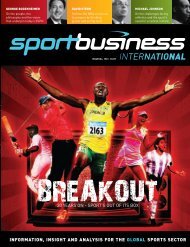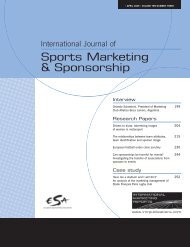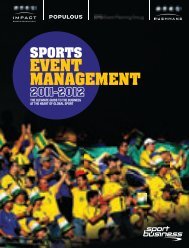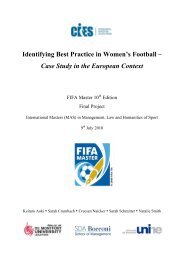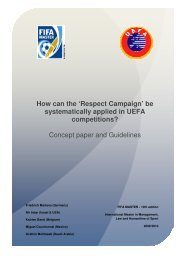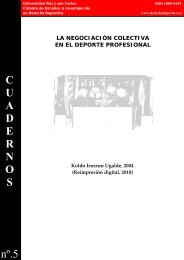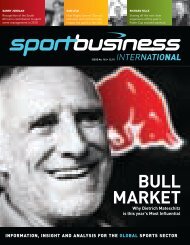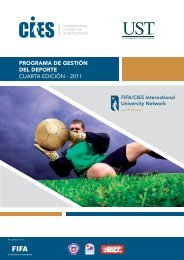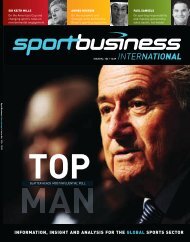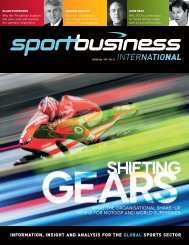Sports Marketing & Sponsorship - FIFA/CIES International University ...
Sports Marketing & Sponsorship - FIFA/CIES International University ...
Sports Marketing & Sponsorship - FIFA/CIES International University ...
- No tags were found...
Create successful ePaper yourself
Turn your PDF publications into a flip-book with our unique Google optimized e-Paper software.
The value of competitionentertainment that consumers value. This paperfocuses on the primary B2C spectator sports product,the event or game, to show that league managementcan influence the value of competitions by managingthe competitiveness of its member teams. The paperdemonstrates that competitive balance, or competitionbetween evenly matched teams, creates higherentertainment value for customers, as indicated by ahigher percentage of tickets sold. The central thesis isthat competition between evenly matched teamspromises greater uncertainty of outcome, creatingmore suspense, and therefore higher entertainmentvalue for consumers. All other things being equal,consumers will buy products that offer higher value.Thus ticket sales volumes are an indication of thevalue that consumers place on the competition.There has been a great deal of academic andmanagerial interest in understanding and predictingfan attendance for international events (e.g. theOlympics), leagues (e.g. English rugby union) andteams (e.g. New York Yankees). Baimbridge (1997,1998) looks at predictors affecting attendance at theOlympics and the Union of European FootballAssociations’ championship. Schmidt and Berri(2003) review season-long measures for severalleagues, including the Bundesliga, Germany’s topsoccer league. Boyd and Krehbiel (2003) examinefactors related to game attendance for MLB teams.Similarly, Dobson et al (2001) and Meir (2000) focuson issues connected to match attendance forprofessional rugby. Garcia and Rodriguez (2002) andPeel and Thomas (1992) examine predictors ofindividual match attendance for the Spanish andEnglish football leagues respectively.This paper investigates the aggregate effect ofcompetitive balance among teams in a league on theleague’s seasonal attendance. It also controls for therole of exogenous variables that may influenceattendance, such as market demographic andeconomic conditions, as well as changes in thenumber of teams in the league. By focusing on nonmajorprofessional leagues, the analysis is conductedin isolation from attendance-influencing factors suchas national media, star player appeal, heavymerchandising programmes (e.g. as found atAmerican and European professional and Americancollegiate levels), and the school spirit and traditionalrivalries at collegiate level. This research utiliseslongitudinal data from five non-major professionalleagues to examine the effects of competitive balanceover multiple seasons.The paper presents a review of past studies offactors that influence attendance, followed by aconceptual framework of attendance and proposedhypotheses. The empirical study is described, followedby a report of results and discussion of the findings.Professional sportIn one of the earliest studies of demand, Jones (1969)conceptualises several possible determinants ofattendance including past ticket sales and winningpercentages. Using two seasons of MLB, Noll (1974)develops one of the first models that incorporatesdemographic variables. Baade and Tiehen (1990)extend this model by using 17 MLB seasons to refinethe variables in Noll’s model. In both studies, marketsize and market income were found to be statisticallysignificant in predicting attendance, as were teamstandings within the league and competition fromother spectator sports.Subsequent studies investigate various factors thatinfluence attendance at a game including betting odds(Knowles et al, 1992; Peel & Thomas, 1996),perceived probability of home team success (Borland& Lye, 1992; Hynds & Smith, 1994; Peel & Thomas,1992; Welki & Zlatoper, 1994), timing of promotions(Boyd & Krehbiel, 2003), game day atmosphere (Meir,2000) and changes in league structure (Dobson et al,2001). Among research that focuses on seasonalattendance data, factors that influence fan demandinclude winning seasons (Wells et al, 2000), marketincome (Robinson & DeSchriver, 2003), team location(Jones & Ferguson, 1988) and impact of playerperformance (Greenstein & Marcum, 1981; Paul,2003). Factors that influence attendance at regularlyscheduled international tournaments include perceivedRESEARCH PAPER● OCTOBER 2009 ● <strong>International</strong> Journal of <strong>Sports</strong> <strong>Marketing</strong> & <strong>Sponsorship</strong>9


